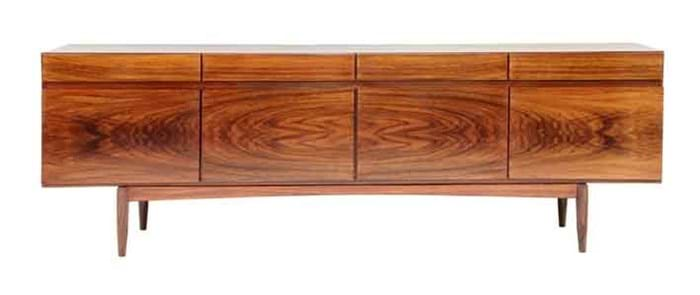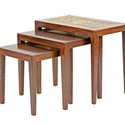CITES specialist Kim MacDonald, who works as a consultant to a number of regional auction houses, reminded the Stansted auctioneers that post-War rosewood furniture - like the parts and derivatives of other endangered species - cannot be sold without appropriate paperwork from the Wildlife Licensing & Registration Service.
The term 'rosewood' can refer to any of a number of richly hued timbers, often issuing the strong sweet smell which gave them their name. Commonly encountered types include East Indian rosewood (Dalbergia latifolia), Indian rosewood (Dalbergia sissoo) and Brazilian rosewood (Dalbergia nigra)*.
Not all species are problematic. Dalbergia latifolia and Dalbergia sissoo, for example, are listed by CITES in categories that refer only to raw timber rather than finished furniture. But Dalbergia nigra, the favourite of English cabinetmakers in the Regency period and the Scandinavian modernists, is now threatened by habitat loss and was CITES-listed in Annex A, Appendix I in 1992 and thus subject to tight controls that covers all derivatives.
Danish Modern Style
Of course, most pieces of antique rosewood furniture enjoy an exemption from the controls under the 'antiques derogation'. This states that an item shall be exempt from normal sales controls if it was acquired prior to March 1947 and has been significantly altered from its natural state before that date.
But furniture made in the Danish modern style in the 1950s, '60s and '70s falls after the cut-off date and needs to be accompanied by a so-called Article 10 certificate from the Wildlife Licensing & Registration Service in Bristol in the event of its sale (or advertising for sale).
The certification process currently carries a cost of £31 per item per transaction, although charges are currently scheduled to increase to £68 by 2015.
Sworders decorative arts specialist John Black conceded he was unaware of the law that is often flouted in regional salerooms. He told ATG the firm now intend to apply for certificates to sell each of the withdrawn rosewood items at a later date - even the many pieces estimated under £300 - in the belief that a strong market exists for this material.
Other Scandinavian pieces made in teak, oak and walnut (woods that do not appear on the CITES list) remained in the late January sale. "Speaking to members of the trade the legislation is not well known. It spoilt my day but it has been a lesson for us all," he said.
*Determining the precise species of rosewood can be difficult. It is possible to send a small sample of the wood for laboratory testing at the Royal Botanic Gardens, Kew (at a cost of around £120) but typically this is an invasive procedure unsuitable for furniture or works of art. It is preferable instead to assume the timber is Dalbergia nigra and apply to the Wildlife Licensing & Registration Service for a licence.








